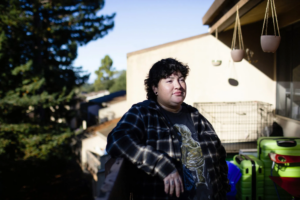The Hidden Financial Aid Hurdle Derailing College Students
Critics say requirements conditioning federal aid on ‘satisfactory academic progress’ are confusing and overly punitive. Legislators are taking notice.
At 19, Elizabeth Clews knew attending community college while balancing a full-time job and caring for a newborn would be hard. But she wanted to give it a shot.
After a few months, the single mom, who had just exited the foster care system, realized she wasn’t doing well enough to pass her classes at Ventura College. “All I could really focus on was taking care of my baby and making sure that I kept a roof over our heads,” she said.

After her first semester at Ventura College, Elizabeth Clews received a notice that she’d run afoul of “satisfactory academic progress” rules and was at risk of losing her financial aid. Credit: Talia Herman for the Hechinger Report
Clews thought her performance would improve if she quit work. But when she logged into the school’s online portal to register for a second semester, a message popped up that she described as saying, “You can enroll for classes, but you’re not gonna get financial aid.” Clews was in danger of failing to meet a standard called SAP, or “satisfactory academic progress,” which is attached to nearly all federal financial aid for higher education — including grants, loans and work study — and most state aid too.
“I didn’t really know it was a thing,” Clews said, “I didn’t understand any of the financial aid terminology.” But one thing she knew with utter clarity: She couldn’t pay tuition and fees out of pocket. So, she dropped out.
The number of students across the U.S. affected by satisfactory academic progress requirements each year likely runs in the hundreds of thousands, yet until recently the issue garnered almost no attention fr
om news media, academics and policy makers. “It’s not a noisy problem” because it doesn’t impact people with social capital and power, said Christina Tangalakis, associate dean of financial aid at Glendale Community College in Southern California.
Now, a loose coalition of nonprofits, legislators and financial aid administrators are trying to reform what they describe as overly punitive, vague standards that keep many students capable of earning a degree from obtaining one. The state of Indiana was an early actor, creating a grant in 2016 for returning students who had “SAP-ed out” of federal funding. Last month, California enacted legislation to make all colleges align their requirements for “satisfactory academic progress” with the federal minimum standard.
At the federal level, 39 nonprofit organizations sent a letter in August asking the U.S. Department of Education to clarify the rules around the SAP minimum requirements. And in Congress, Sen. Cory Booker, a Democrat, is expected to re-introduce SAP-related legislation that would give students a second chance at aid.
The logic behind satisfactory academic progress rules is that giving aid to students who are unlikely to graduate is a bad investment, wasting students’ time and taxpayers’ dollars.
The policy was created in 1976, and at first, each college or university was left to set its own standards. Then, in a 1981 report to the Senate, the General Accounting Office said tougher ones were needed. Citing little evidence, the agency asserted that $1.28 million had been accessed inappropriately.
“It was Reaganomics and welfare reform and this idea of deserving and undeserving poor,” said Debbie Raucher, the director of education for John Burton Advocates for Youth, or JBAY, a California nonprofit. The stance was “if a student isn’t pulling their weight, they don’t deserve our help,” she said.
Under current federal rules, students must maintain a 2.0 GPA or higher, complete at least 67 percent of credits attempted and stay on track to finish a degree in no more than 150 percent of the time it usually takes (for example, six years for a four-year degree). During the Obama administration, SAP regulations were further tightened in an attempt to prevent low-performing for-profit institutions from lining their pockets with taxpayer dollars.
Once a student becomes ineligible for financial aid after failing to make SAP, that status stays with them forever.
Some students appeal, but that process can be complicated and riddled with inconsistencies. Campuses aren’t required to offer appeals. Those that do must limit grounds to “the death of a relative, an injury or illness of the student, or other special circumstances,” according to federal regulations. What circumstances qualify as “special” varies tremendously. For example, some schools explicitly allow students to appeal if they are struggling to balance school and work demands, while others explicitly disallow appeals on the same grounds, according to a 2023 analysis by JBAY.
At 20, Clews didn’t know anything about an appeal, but two years later, she felt “this itch to try again,” and attempted to re-enroll at Ventura. When she got a similar notification, a more mature Clews “decided to do some investigating.” She had experienced homelessness and food insecurity, but didn’t see those circumstances on the appeals list. Her takeaway was: “Oh, well you didn’t die, you didn’t get your leg cut off, so there’s no reason that you shouldn’t have been successful.”
So Clews worked as a waitress and in retail for the next five years.
